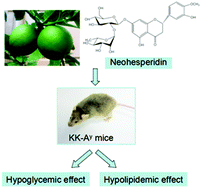Hypoglycemic and hypolipidemic effects of neohesperidin derived from Citrus aurantium L. in diabetic KK-Ay mice
Abstract
The present study is to investigate the possible hypoglycemic and hypolipidemic effects of neohesperidin (NHP) derived from Citrus aurantium L. in vivo. KK-Ay mice were used as the diabetic experimental model, whereas C57BL/6 mice were used as normal control for a 6-week study. Treatment of NHP significantly decreased fasting glucose, serum glucose, and glycosylated serum protein (GSP) in KK-Ay mice. It significantly elevated oral glucose tolerance and insulin sensitivity and decreased insulin resistance in the diabetic mice. In addition, NHP significantly decreased serum triglycerides (TG), total cholesterol (TCH), leptin level, and liver index in the KK-Ay mice. NHP also inhibited lipid accumulation in the liver and decreased the size of epididymal adipocyte in the KK-Ay mice. Gene expression of stearoyl-CoA desaturase 1 (SCD-1) and fatty acid synthase (FAS) were significantly inhibited, whereas the expression of acyl-CoA oxidase (ACOX) was significantly induced by NHP treatment in the liver of KK-Ay mice. In addition, elevated level of phosphorylation of hepatic AMPK was observed in NHP-treated mice. Therefore, the activation of the AMPK pathway and regulation of its target genes, including SCD-1, FAS, and ACOX, may play important roles in the hypoglycemic and hypolipidemic effects of NHP in vivo, and NHP may have great potential in the prevention of diabetes and its complications.


 Please wait while we load your content...
Please wait while we load your content...